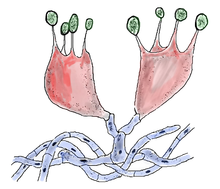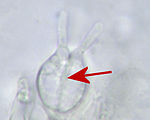Basidie
Basidia (singular: Basidie or Basidium ) are the meiosporangia of the mushrooms (Basidiomycota). As with Asci of Ascomycota (Ascomycetes) there are different forms even in the basidia. The spores that arise on basidia are called basidiospores . The basidia are primarily single-celled, there are also secondary developments with two- or four-cell structures. Basidiomata or basidiocarpia are the fruit bodies (stand mushrooms) and fruit stores ( rust and smut fungi ) in or on which the basidia mature. The organ for spore formation is the fruit layer . Usually four spores develop per basidia, but there are also deviations (two or eight spores). These can be formed freely or on special stem-like protuberances, the sterigms.
The origin of the basidia, their structure and the type of release and germination of the basidiospores are important criteria for classifying the species in the system of mushrooms .
Basidia formation
The basidia usually arise as a modification of a buckle formation . In addition, there is the possibility of budding from end cells of dikaryotic hyphae in species without buckles. A third variant is the formation of the basidium from a probasidium .
Basidium classification
Most noticeable is the formation of unseptate and septate basidia. Both basic types can be further differentiated according to further aspects such as form and approach.
Holobasidy
The holobasidy is unicellular and unseptate. The nuclei created sexually by nuclear fusion and reduction division migrate into the protuberances formed on the apex region and form the basidiospores there on the sterigmas .
Phragmobasidy
In contrast to the holobasidy, the phragmobasidy is always septate. The word stem Phragmo- is derived from the ancient Greek word "phragma" (genitive phragmatos) and can be translated as fence, partition or partition. There are two different types of phragmobasidia. In the Auricularia type, the basidia is divided into four individual cells by three transverse septa, and in the Tremella type by two longitudinal septa. The septa arise immediately after the reduction division. Fungi with phragmobasidia used to be grouped together in the subclass Phragmobasidiomycetidae , but the species with phragmobasidia do not form a natural family group.
Hypobasidia and epibasidia
Hypobasidia is the basal, often spherical to pear-shaped part of a longitudinally divided basidia of the tremor mushrooms, on which the spore-forming epibasidia is formed, which consists of the more or less finger-shaped sterigms. Basidia divided into hypo- and epibasidia are mainly found in the family of the Tremellaceae .
Different types of holobasidia
Repetobasidia
One speaks of repetobasidia when young basidia do not grow past older ones laterally, but through the old ones. As a result, young basidia are often surrounded by a multilayered shell made up of the remains of the old basidia. This is also known as the inner basidia repetition. Repetobasidien be found in the corticioiden fungal genera Repetobasidium , Repetobasidiellum , Galzinia and conferticium ago.
Pleurobasidia
Usually basidia are formed at the end of a hypha. With the pleurobasidia, however, they arise laterally. They therefore have only a short hyphal process at their base.
Acanthobasidy
Acanthobasidia occur in some mushrooms with corticoid fruiting bodies. In these mushrooms the basidia have spiky or finger-shaped outgrowths, as can also be found in acanthohyphids. Acanthobasidia are typical, for example, of Acanthobasidium , a genus from the family of layer mushroom relatives (Stereaceae). But they also occur in some other layer and bark fungi.
Different basic service stages
Probasidy and metabasidy
The first stage of basidia formation is called probasidia, especially if it differs significantly from the later, mature stage (metabasidia), as is often the case with the heterobasidomycetes . Often the probasidia is round and thick-walled.
Basidiole
Basidioles are club-shaped or cylindrical cells of the hymenium (fruit layer) without sterigms . Mostly they are young or sterile basidia. The term cystidiols is also used for inconspicuous sterile cells in the fruit layer.
literature
- Heinrich Dörfelt (Ed.): Lexicon of mycology. Gustav Fischer, Stuttgart et al. 1989, ISBN 3-437-20413-0 .
- Emil Müller, Wolfgang Loeffler: Mycology. Floor plan for scientists and physicians. 5th revised edition. Thieme, Stuttgart et al. 1992, ISBN 3-134-36805-6 .
- Constantine John Alexopoulos: Introduction to Mycology. Gustav Fischer, Stuttgart 1966.
Web links
- The basidia. Xander's 10th letter. In: vapko.ch. VAPKO (Swiss Association of Official Mushroom Control Bodies), accessed on October 25, 2011 .
Individual evidence
- ↑ Lexicon of Biology. In: Spektrum.de. Retrieved January 29, 2015 .
- ^ A b c German Josef Krieglsteiner (Ed.): Die Großpilze Baden-Württemberg . Volume 1: General Part. Stand mushrooms: jelly, bark, prick and pore mushrooms. Ulmer, Stuttgart 2000, ISBN 3-8001-3528-0 , pp. 53-56.



